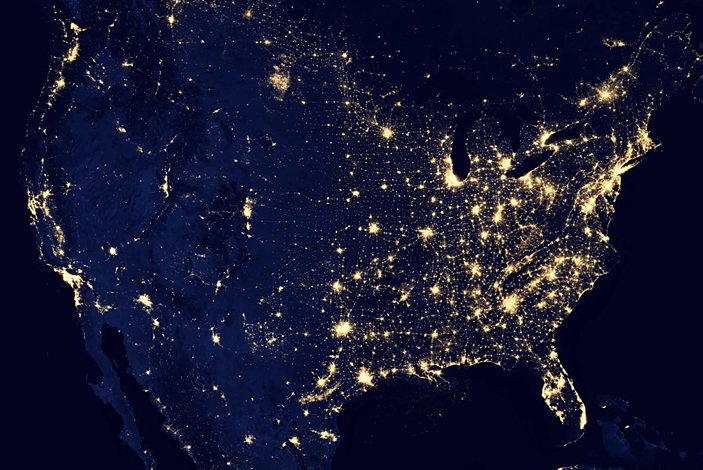
Here’s a kind of weather you may not know about:
Every few days, the sun emits electrically charged particles, which stream to Earth in what we call solar wind. And when solar wind meets Earth’s magnetic field, we sometimes get…a magnetic storm.
Magnetic storms can interfere with satellite, GPS, and radio signals. But their most serious effect is when they create electric fields in Earth’s interior.
These electric fields have melted power-line transformers and even caused a power grid in Canada to fail, leaving 6 million people without electricity.
Magnetic storms are more common at higher latitudes, where they create the famous Northern Lights. During intense storms, these auroras can light up the sky much farther south, into the central United States and beyond.
How much a magnetic storm could affect the power grid depends on geology. Sedimentary rocks, like sandstone and limestone, are good conductors. In areas with these types of rocks, the natural currents tend to stay in the ground.
But igneous rocks, like granite, are poor conductors. Here, electric fields look for more conductive paths, which tend to be manmade networks, like power grids—which may not be able to withstand that unpredictable extra current.
To help utility companies safeguard against these effects, scientists are combining ground-conductivity data with magnetic-storm history to produce a geoelectric hazard map.
It’s a new way of weather forecasting that just may help keep the lights on.
Background
Synopsis: The sun is the source of a solar wind of electrically charged particles. Magnetic storms are caused by the dynamic interaction of the sun and its solar wind with Earth’s magnetic field. At high latitudes, magnetic storms give us beautiful auroras. But magnetic storms can also interfere with technological systems of importance to modern civilization. In particular, intense magnetic storms can generate electric fields in Earth’s interior that interfere with the operation of electric-power grid systems. Utility companies would like to know where on Earth these space-weather-generated hazards are greatest.
- Solar flares and ejections of plasma and magnetic-field emanations cause sudden bursts of radiation, or solar flares, which cause space-weather effects here on Earth.
- Magnetic storms can adversely affect technological systems of importance to modern society. They can disrupt over-the-horizon radio communication, degrade the accuracy of GPS, damage satellite electronics, alter satellite orbits, and interfere with directional drilling for oil and gas.
- Of particular concern are electric fields that are induced in Earth’s electrically conducting interior. During intense magnetic storms, these geoelectric fields can be of sufficient strength to drive uncontrolled currents in high-voltage power-grid systems, interfering with their operation, and sometimes even causing blackouts and damaging high-voltage transformers.
- An early sign of the potential effects of space weather came in September 1859. An intense magnetic superstorm brought auroral displays to very low latitudes, as far south as Cuba and Hawaii. It also played havoc with the telegraph systems that were in operation in those days, in some cases even causing telegraph stations to catch fire.
- Much more recently, the magnetic storm of March 1989 melted power transformers in New Jersey, causing the collapse of the entire Hydro-Québec power-grid system in Canada, leaving 6 million people without electricity for over 9 hours.
- Generally speaking, geomagnetic activity is most intense within a range of latitudes where auroras tend to be brightest. During intense magnetic storms, this auroral zone expands southward. In North America, it sometimes extends all the way from Canada down into the central continental United States.
- The degree to which storm-time magnetic activity generates electric fields in the earth depends on the nature and composition of the underlying rock. Some rocks—like water- filled sedimentary rocks—are better conductors than others. Old, dry igneous rocks—like those found deep beneath southeast Canada and some Midwestern states in the United States—do not conduct electricity very well.
- Since electric currents flow along the path of least resistance, geoelectric fields, generated during a magnetic storm, end up driving currents through manmade conduction systems, like power grids, deployed across Earth’s surface.
- To help utility companies better estimate how their power-grid systems can be affected by magnetic storms, scientists at the U.S. Geological Survey, working in collaboration with colleagues at NASA, NOAA, and other federal government agencies, have recently produced maps of geoelectric hazards.
- Their work brings together estimates of ground conductivity obtained during geophysical surveys and of extreme-event geomagnetic activity obtained from historic measurements of magnetic storms. Their research will ensure that electricity can continue to be reliably delivered to our cities, towns, and homes in the future.
- Where data are available within the United States, areas of particular concern include Minnesota and Wisconsin, while areas like Florida have less ground-conductivity risk.
- Over the next couple of years, scientists will obtain data allowing them to evaluate geoelectric hazards for the northeastern United States, an area of high population density and significant power-grid infrastructure.
Additional information:
The U.S. National Science and Technology Council has organized such interagency work through its Space Weather Operations, Research, and Mitigation (SWORM) project.

